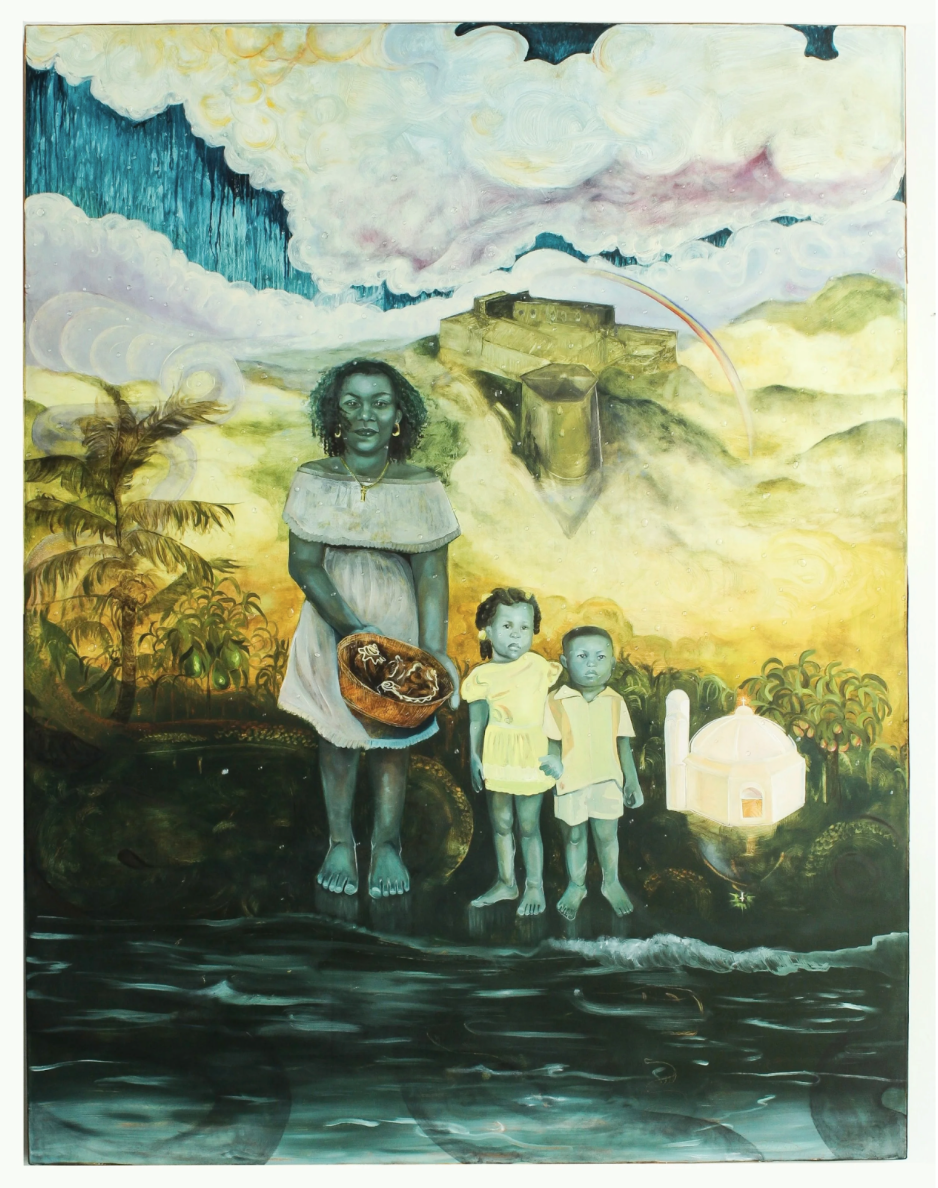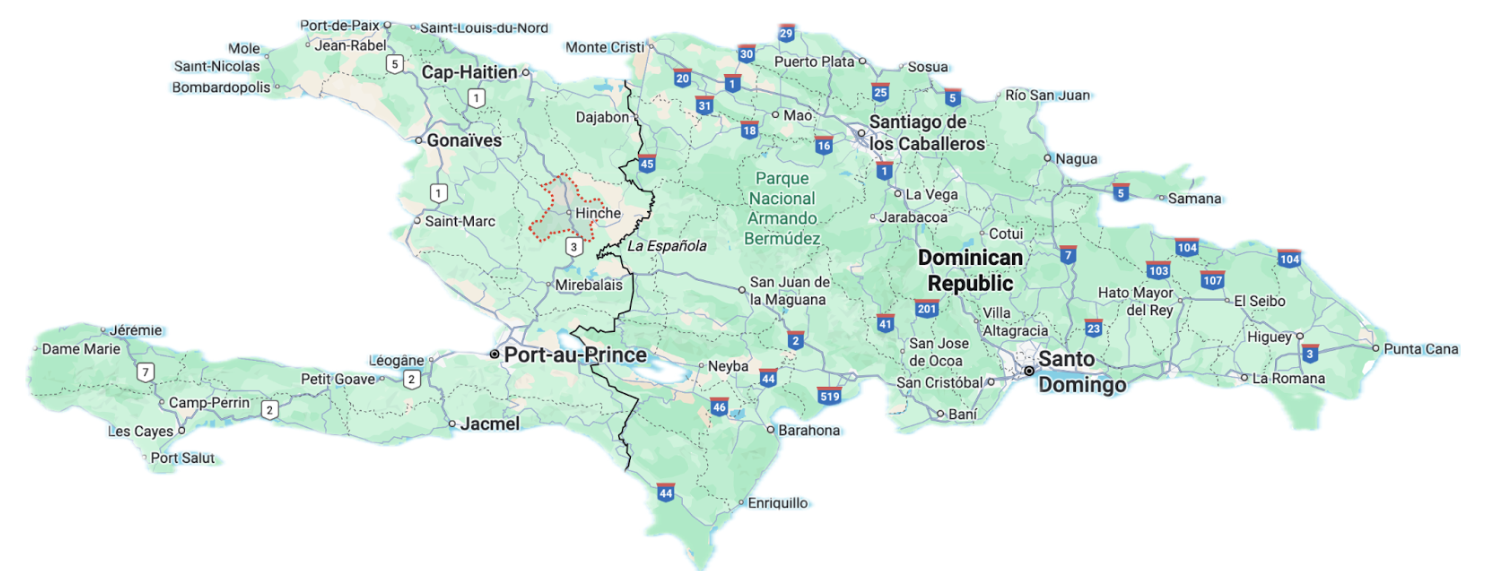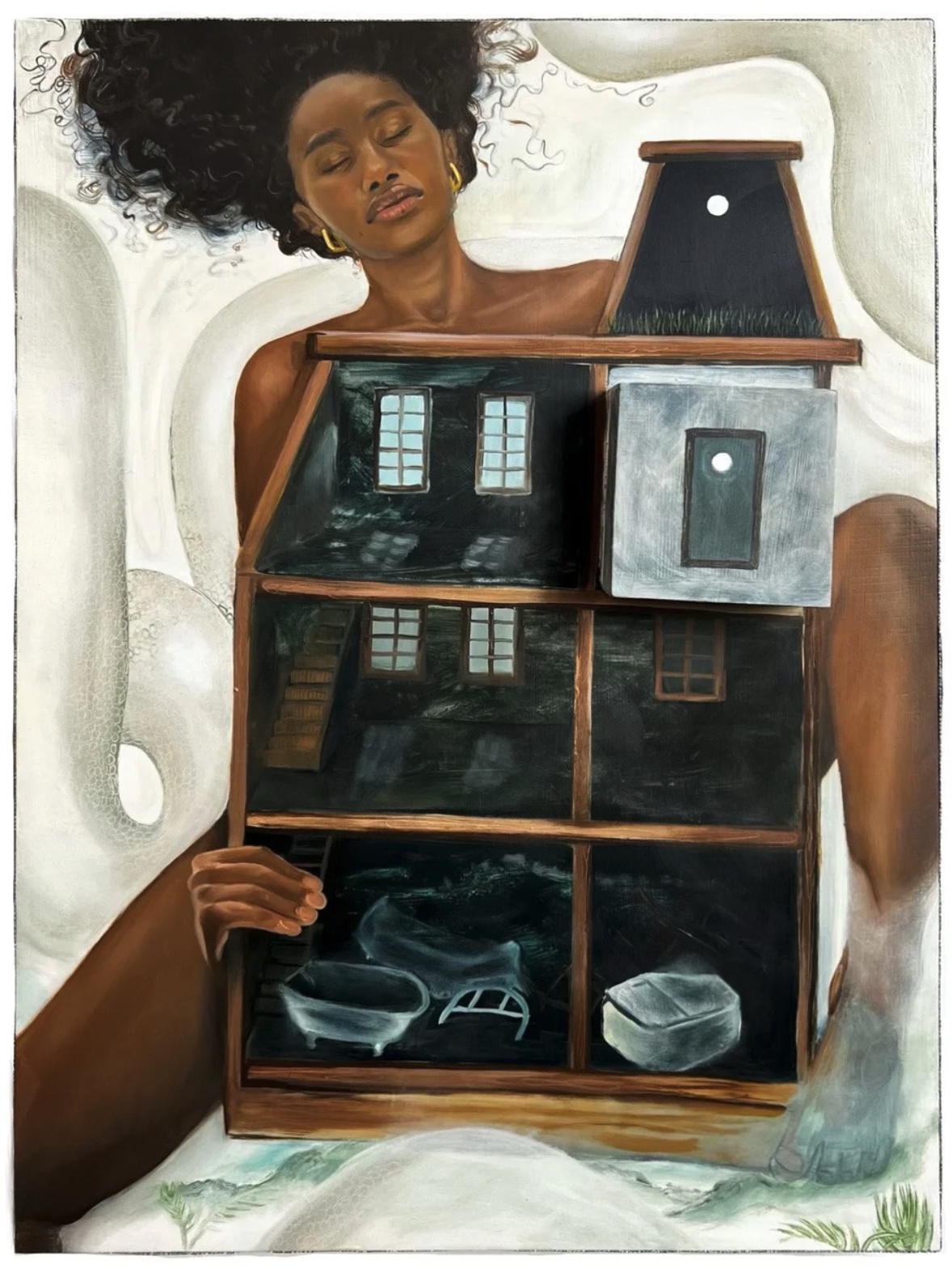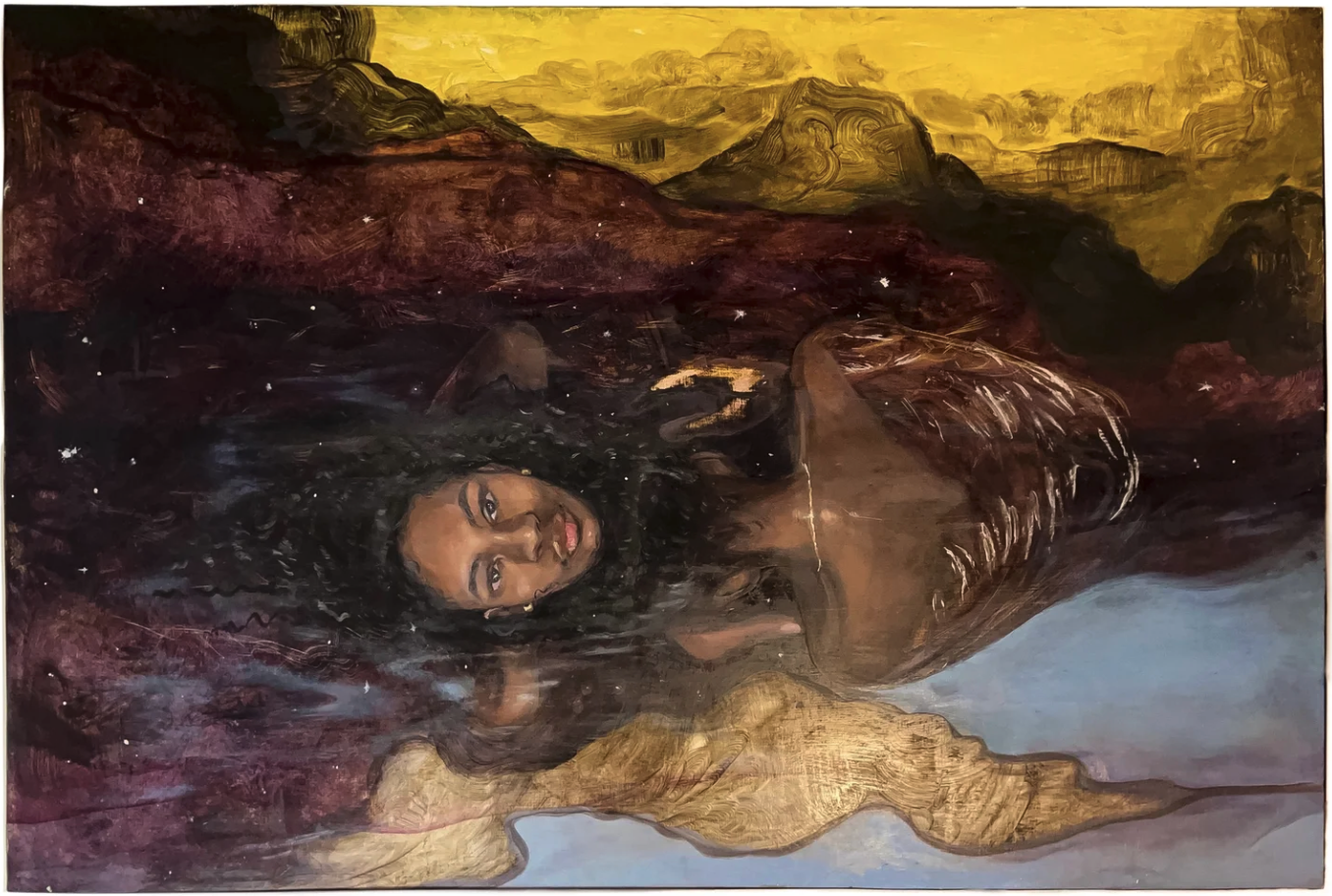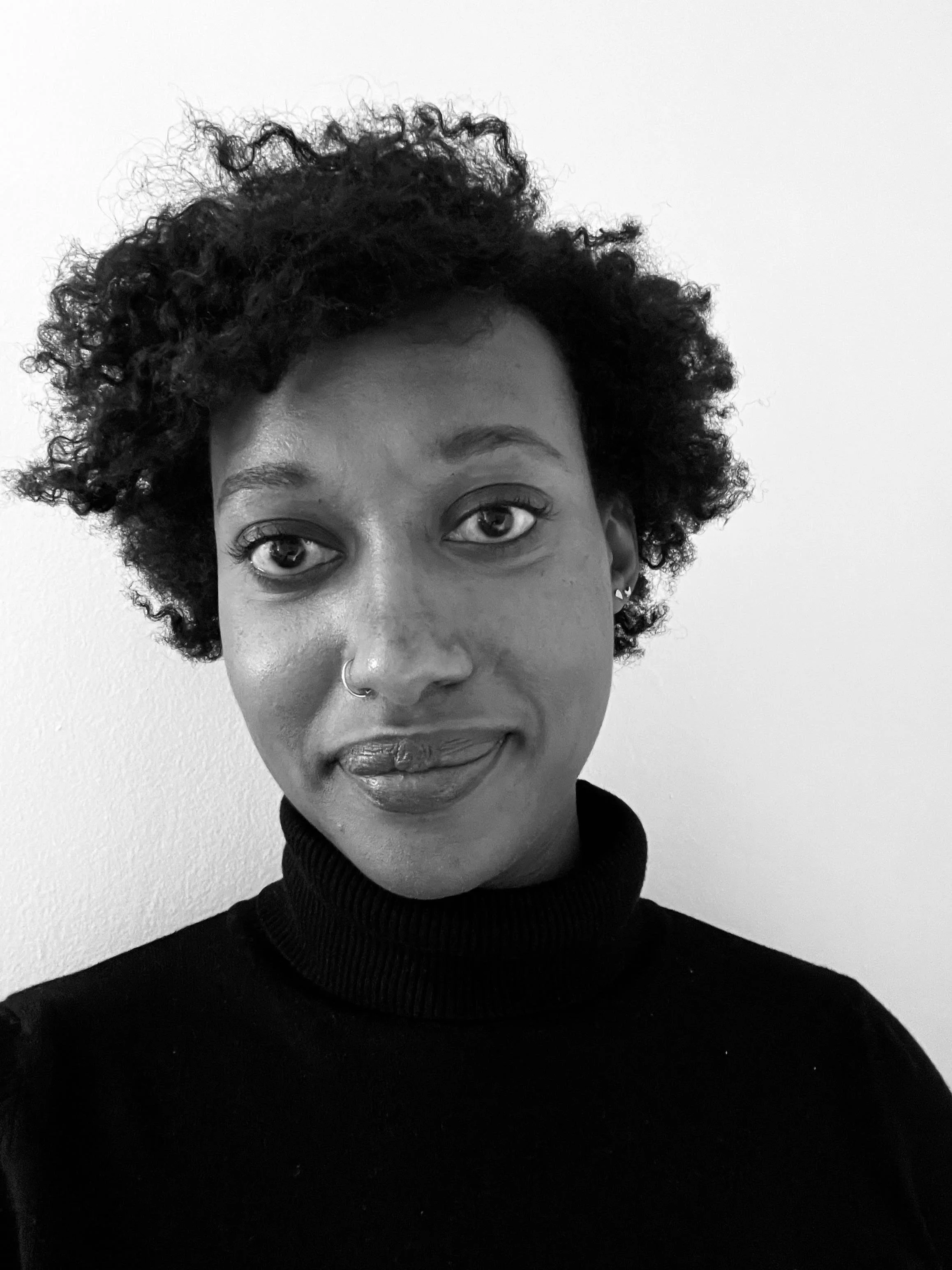Unlocking the Power of Jenna Arvelo: An Interview by Ayanna Legros
2023, Raised of Dragons, Oil on primed Canvas, Velvet, Resin, Oil Stick 72' x 56' inches.
This interview delves into the powerful work and influences of Haitian-American and African-American artist, Jenna Alvero, whose oil painting “Raised of Dragons”, 2023 was exhibited in the group show, “Black New York” at Galerie Shibumi (on view from August 8th - September 6th, 2025). It was curated by G.S. Director, Folana Dione Miller and featured the following artists: Shasekh Augustin, Jenna Arvelo, Maya Beverly, SantanaCopeland, Nyzere Dillon, Laura Gayle, Garry Grant, GOODW.Y.N., Kahdeem Jefferson, Leah King, Ayanna Legros, Emily Manwaring, Alexis Mendoza, Aala Oni, Iris Phenix, John Ricard, Haley Sessoms, Alisa Sikelianos-Carter, Christina M. Tapper, Atiim Turnbull, Michael Young, and Zawadi.
September 10th, 2025, with Jenna Arvelo
Ayanna Legros: Tell me about yourself.
Jenna Arvelo: Well, I'm a 30-year-old artist and educator. I'm from New Jersey and I was originally born in New Jersey. My father is Haitian, and my mom is a Black American. My father is first generation, well, not first generation. He was born in Haiti, so I am technically first generation. And we've been based in Brooklyn for a really long time. My grandma lived there for over 60 or 70 years now and is still there. I come from a pretty big family, but I've always been interested in art, and my parents have been pretty supportive, especially my father, surprisingly enough. Because we know, you know, Haitian families don't really expect you to be an artist. They expect you to be a doctor, a nurse, or a lawyer. But I was lucky enough to have a lot of support growing up in really exploring, drawing at first, and eventually painting when I got old enough, and when I did get into painting, it was probably around 2012 or 2013. And I've just been painting ever since.
Ayanna Legros: Tell me about the moment that you knew you wanted to be a painter.
Jenna Arvelo: In undergrad. I went to Rutgers Newark. They had a small program at the time, right now it's pretty much nonexistent, unfortunately, but the stars aligned and I got into Rutgers. I met my mentor, Jordan Casteel, and she's sort of introduced me to the language of painting and the art world and I think that was the first time in my life that I realized that I could seriously consider doing this and being a real artist, I guess you could say, through also watching her in her career, but also her personally encouraging me to pursue it as well.
Ayanna Legros: So, did you ultimately become an art major from having these conversations with your mentor and feeling like you could do this?
Jenna Arvelo: [Yes], knowing that I was always interested in it and it just seemed like the thing to do for me, but, yeah, she ultimately clarified and made it really obvious that, “yeah, this is your path.”
Ayanna Legros: That's wonderful. So, a lot of your work explores ideas of memory, the past, heritage, and gender. I'm a fan of your work outside of just seeing elements of Haiti represented, but I heard you at the closing of the show share some elements of your family history and how it inspires you. Would you be willing to say more about the piece that you exhibited at “Black New York”?
Jenna Arvelo: [That oil painting includes] my grandmother, my aunt, and my father. These were images that I collected from, our family archive of photos, mostly, especially the younger versions of my aunt and my father. I found those photos and just pasted them on there, through painting. But yeah, it's a self-portrait, but not a self- portrait. It's a portrait of them, and they're sort of immigration path to America, but a lot of the elements are references to my grandmother's hometown and the Citadel, which is a fortress that you also clarified more for me when we last saw [each other]. It was a fortress that was created after the [Haitian] Revolution as a response to not wanting to be enslaved again by [European powers] as well as the mystical elements of our connection with the rainbow, our natural world, and snakes, and how it creates this, not just the language, but a visual representation of our spiritual belief and how they are all sort of interconnected in this relationship of fertility and life.
Ayanna Legros: Tell me about some of the colors that you selected. Clearly you did not paint the image of your father and your aunt and your grandmother as, you know, in brown skin. You chose some really unique colors and shades, and I was completely engulfed by the ways in which you used saturation. Could you speak more about what inspired you to use the colors that you did?
Jenna Arvelo: My palette, I think is of Haiti. [I] think of how vibrant it is in comparison to how people sort of have been perceiving it in the media and how media represents it. I think of it as a vibrant, beautiful island that has a plethora of wealth and not just the soil, but in our culture and our people. And I think intuitively, I was trying to reflect that in my palette, but also the photos that I used were sort of in black and white, so I had a lot of creative liberties that I could take, and representing, not just like [showing], the aged quality of the photos in the painting, but also relating the color back to the greenness and lushness of it.
Ayanna Legros: Wonderful and tell me more about the building that is included in the painting.
Jenna Arvelo: That was created in response to the revolution that happened against the French. And the other one in the lower element of [the painting] is symbolic [of the] language of strength and the toughness that Haitians have, but you also have it there as a means of remembering our history, and, also sort of bouncing off my grandmother's strength, her resilience, and also her sort of ironclad [traits] that she possesses within herself.
Ayanna Legros: And tell me also about the other building. It looks like a church [or] a cathedral? What specifically is it?
Jenna Arvelo: There is a cathedral in my grandmother's hometown. It is one of the landmarks there. As you know, Haiti is mostly Catholic, I believe, and so is my grandmother. She is still a practicing Catholic. I thought it was probably important to include that as well as it being sort of representative of her hometown. It's also representing her religion and what she practices, even though I still have those elements of Vodou there. Both are very much relevant because we often had to hide our practices under the guise of Catholicism. Well, it still pretty much exists in our day-to-day way of life.
Ayanna Legros: Did you come across that cathedral through a photograph or through a story?
Jenna Arvelo: Through photographs.
Ayanna Legros: And tell me about your name, Jenna. Who selected it? And tell me if you know anything about the significance of your last name.
Jenna Arvelo: My dad named me. They didn't come up with Jenna at first. My name was going to be Genevieve after him. His name is Jean Maxime, but my aunt convinced him to give me an easier name, I guess, so they came up with Jenna. My middle name is Gabrielle, but it is also my aunt's name that is in the painting. So, I'm sort of named after her. And then Arvelo is kind of a mystery to me.
Image credit: Google map image of Haiti and the Dominican Republic (Hinche is encircled in red)
Jenna Arvelo: But my grandmother's hometown is on the border of the Dominican Republic, so there could be some sort of mixing of cultures there that might have happened. I've looked up the meaning of the last name Arvelo, and there's not a lot on it, but I do see that it is connected somehow to the Canary Islands, sort of like this yellow bird, something like that.
Ayanna Legros: That's fascinating. So, is that on your paternal line?
Jenna Arvelo: Yeah.
Ayanna Legros: And tell me about your maternal line.
Jenna Arvelo: Yeah, my maternal line is actually quite fascinating. We are, well, my mom is from Boston, Massachusetts. Well, no, Roxbury, Massachusetts. They moved to Newark when she was in her early teens. Yeah, most of her family is based in Massachusetts, but a lot of our folks also came from the South, from, like, Virginia. We've been doing a lot of research on our family line over here, and we've found [that] a lot of our relatives that escaped slavery came to the north or we even found out that we are related to Lewis Howard Latimer, who helped create the light bulb. Yeah, so we have a lot of different interesting people in our family, on my maternal line, but mostly based in Massachusetts.
Ayanna Legros: Did you grow up entirely in New Jersey?
Jenna Arvelo: Yeah. So, my parents eventually divorced.
Ayanna Legros: How did you explore being both African American and Haitian American? And how do you think that shows up in your work?
Jenna Arvelo: Yeah, it's kind of hard because I grew up in a Black neighborhood, but there were not particularly any other Haitian people. There was a lot of bullying around, so it was hard growing up with my Haitian roots without feeling like it threatened others. So, I mostly was comfortable just expressing it as just Black at that time. But growing up I was always around my grandmother [and] around my dad. They were always dropping gems on me, and you know, making sure that I was still aware of our culture, aware of our people, and our history. I [did] a lot of my own research, though, too, so being ultimately curious about where we come from and what our culture is like and what our practices were - that was really up for me to discover in a lot of ways, but, yeah, together those different identities, weren’t always easy [for me]. I think when it comes to exploring just, you know, my African American heritage, that's always been sort of like a given. We've always had this narrative of, you know, we're descendants of slaves here, and we're all sort of looped together in this experience of being Black in America and sort of trying to make it work in this patriarchal society, but ultimately there's always a lot more information missing than that, and I realized that growing up, a lot of it was up to me to sort of piece together [and make] my own conclusion and my own epistemology of how things actually are.
Ayanna Legros: What were some of the things that you learned from your grandmother about Hinche?
Jenna Arvelo: Mostly she talks about her way of life, like, she grew up under a diplomat, and she had a lot of privilege in Haiti, but [she] was also living a very strict life. And my great-grandfather really focused on having a thorough education, and was a very big Catholic. But yeah, she always talks about loving the slow life there [and] always having access to fresh fruits on her home property. They had mango trees outside.
Ayanna Legros: I'm really fascinated by your portraits, specifically the one in which you embody a home. Would you mind sharing a little bit about that?
I Dreamt of Mother Home, Oil on panel, Velvet 24' x 18' x 4' x 4' x 2' inches.
Jenna Arvelo: It is inspired by my childhood. And it's again sort of tying back to the Lwa spirits. I'm particularly connected to Damballa (*note by author: it is also written as Dambala, Danbala, and Damballah) and his imagery comes out the most in my paintings, I believe. And yeah, that painting is called “I Dreamt of Mother Home” and it's mostly about nostalgia. It's about yearning for places that I've personally never been to, but wanting to feel that connectedness, although feeling still sort of lost and empty. I think that what I was trying to express [that].
Damballah La Flambeau by Hector Hyppolite (also known as Aida-Quédo and The Snake Goddess Ayida-Wedo) signed ‘H.H.’ (lower right) oil on board 30 x 24 in. (76.2 x 61 cm.) Painted circa 1947. (Description by Christie’s Auction House)
Ayanna Legros: And so, there's another portrait of you and now that you speak about Damballah it makes a lot of sense [in the painting] in which you are almost lying down. I want to pull it up so that I describe it properly because there's so much richness in your work. Yes, there are maroons, deep reds, yellows, browns, that you use in your palette. What is it like for you to explore portraiture?
Jenna Arvelo: It is a triple portrait.
2024, She Lives Beneath Riverbeds, Tucked Between Sky and Land. oil, resin& ribbon on panel, 24' x 36' inches.
Ayanna Legros: I believe so. It's you. It kind of looks like you’re in between two worlds. It's your face surrounded by almost a black abyss. So, this piece is entitled She Lives Beneath Riverbeds, Tucked Between Sky and Land. And you made it in 2024, which is so recent. Yeah. Can you even want to talk about these times? I mean, a lot of your paintings have been made within the past two years, three years, and it's just gorgeous to see the consistency and your execution. Kudos! Tell me about that piece. It really caught my eye.
Jenna Arvelo: Your interpretation of it was kind of on the note; it is between different worlds. And within them [there is] that double portrait. I think I'm referencing the duality, the dual nature of humans in general, and how we sort of have so many different aspects of ourselves, just all at once inside of ourselves. I'm particularly very interested in those different aspects of myself, and I think that we often go looking for other voices to help guide us through life, and there are people that say that everything that we're looking for already exists inside of us, and I think when I'm lost, when I feel like I need that guidance, I try to silence everything else and hone in on that relationship with not just myself, but God too, and that part of me that is still connected to God in that way. Yeah, that's what I'm hinting at in there. And I dreamt of my mother's home and this dollhouse.
Ayanna Legros: When did your father make it for you? And is this an exact representation of what the dollhouse looked like, or is it your interpretation or your memory?
Jenna Arvelo: He finished that for me I was six or seven. It's still exists. It's been in storage somewhere, but it's an exact replica on the inside. It's more loosely interpretive of the image on the inside, but the architectural structure of it is anatomically accurate to what it looks like.
Ayanna Legros: I'm curious to know, what are some pieces that inspire you? What works of art, whether it's music, books, other artists, film?
Jenna Arvelo: Oh, that is hard. There are so many. In grad school Hilma af Klint was really inspiring to me. I first saw her work at the Guggenheim Museum when she had her solo show. You know, almost 100, few hundred years after her death and she sort of prophesized that her work would be in this temple like structure that would spiral, and all these years later, it kind of happened, and not knowing that coming into seeing her show and still being sort of awe-inspired by the works and its symbolic language truly inspired me to make some of the works that I did in grad school. A book that I'm really inspired by these days is Women Who Run with Wolves.
Ayanna Legros: I'm familiar with the book.
Jenna Arvelo: It is delving deep into the wild female archetype, or wild woman archetype, I should say. And she goes through a lot of different fairy tales and history and breaks down how it relates back to these moments of initiation, these moments of awakening intuition, and awakening this inner awareness of our own freedom in our own needs to be wild women. And obviously, Jordan Casteel. She is my mentor, I adore her work, I adore her, and she's been a molder of where I am today with my practice, as well as Naudline Pierre, [who is] also a mentor of mine whom I worked really closely with at some point, and truly, I still respect and hold in high regard till this day.
Ayanna Legros: Wonderful. So, did you also go to graduate school at Rutgers?
Jenna Arvelo: I went to graduate school at Pratt Institute in Brooklyn.
Ayanna Legros: And what was your training in if you don't mind me asking?
Jenna Arvelo: Well, I got my degree in painting and drawing.
Ayanna Legros: Wonderful. If there was something that you could say to anyone right now, what would you say is your message to the world? If someone gave you a microphone, what would you say?
Jenna Arvelo: I would say we need to free ourselves from our own imprisonment of what we think life can be, and in return, we can free each other. I think we all need to work on our heart space a lot and never forget the power of empathy and the power of empathizing with ourselves and others.
Ayanna Legros: And define freedom for me.
Jenna Arvelo: Freedom. Freedom for me is complete autonomy, meaning, I'm able to go where I like, eat good things or healthy things, not feel confined to structures that don't serve me, but freedom, I think, ultimately, is having choice, having power over our choices and finding empowerment [by way of] our confidence in [within] ourselves and our choices.
Ayanna Legros: Wonderful Jenna, I want to thank you so much for your time.
Jenna Arvelo: No, thank you. I really appreciated this.
Jenna Arvelo website: https://www.jennaarvelo.com/ instagram: @jenna.arvelo
Ayanna Legros website: https://ayannalegros.com/ instagram: @haitiharlem
Special thanks to AfroLatin@Forum Executive Director Guesnerth Josué Perea, Galerie Shibumi Assistant Madi Lafemina, and Photographer Soul Brother
Ayanna Legros is a mixed-media artist, Haitian Studies scholar, and radio preservationist
